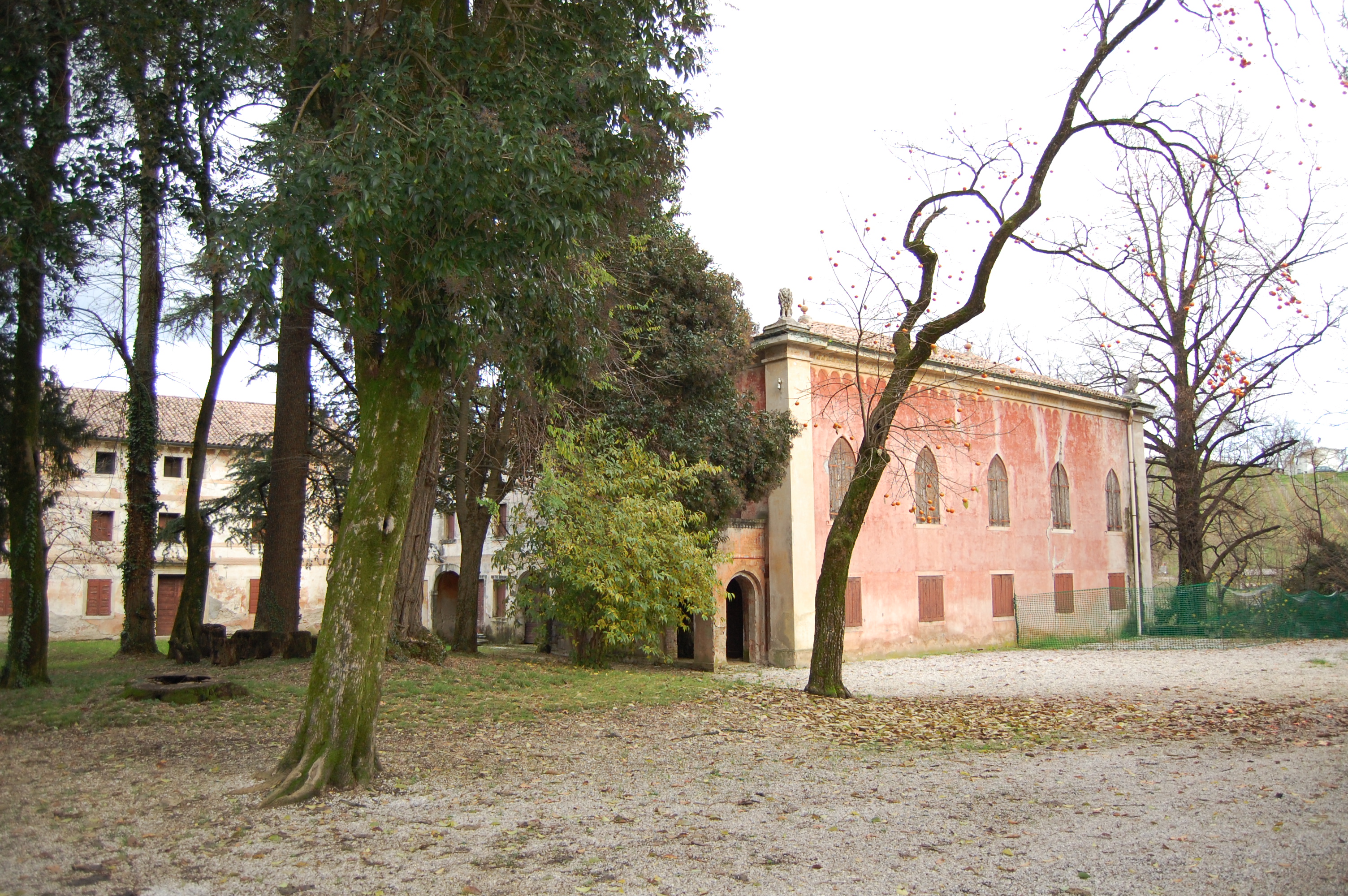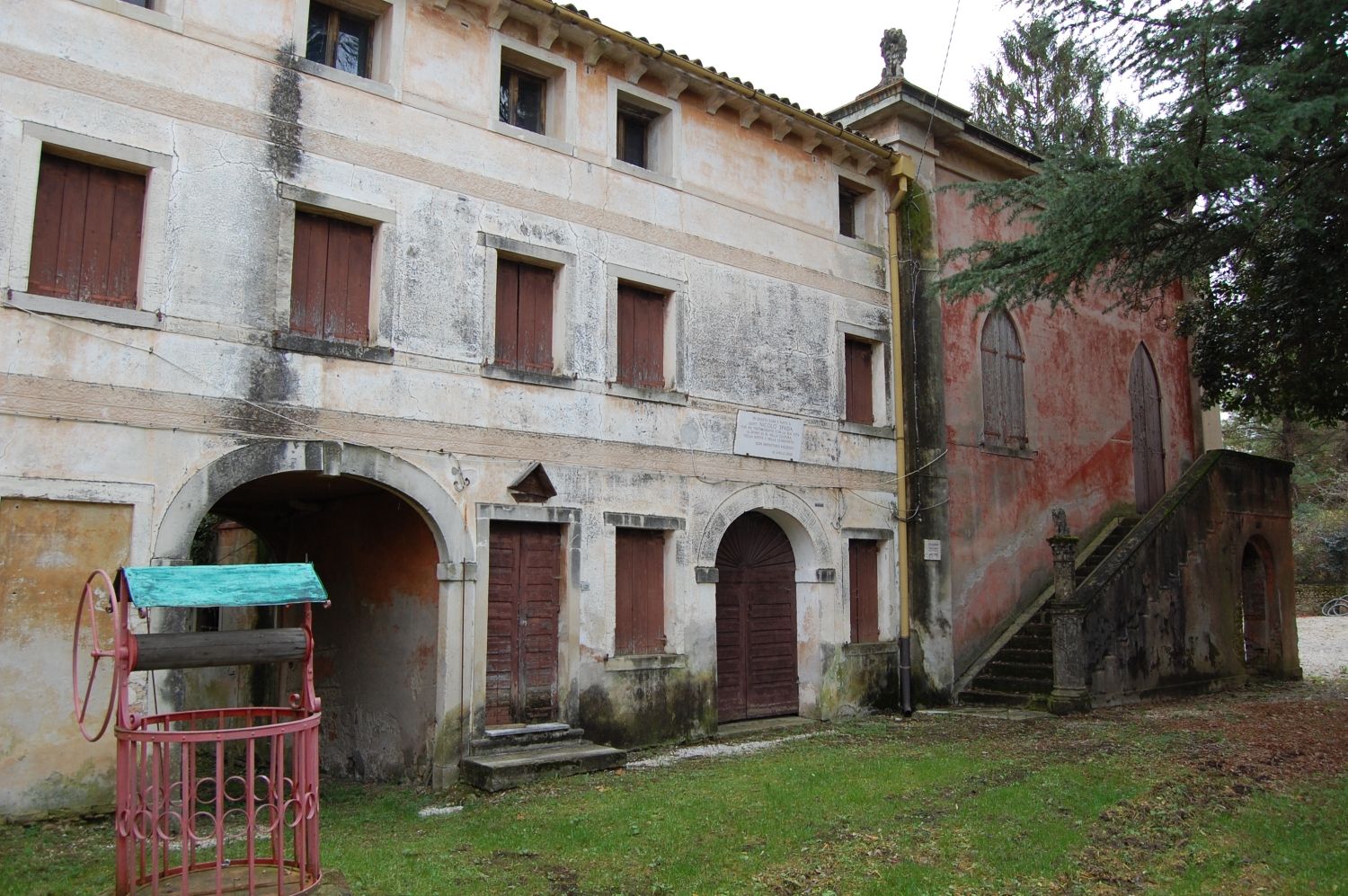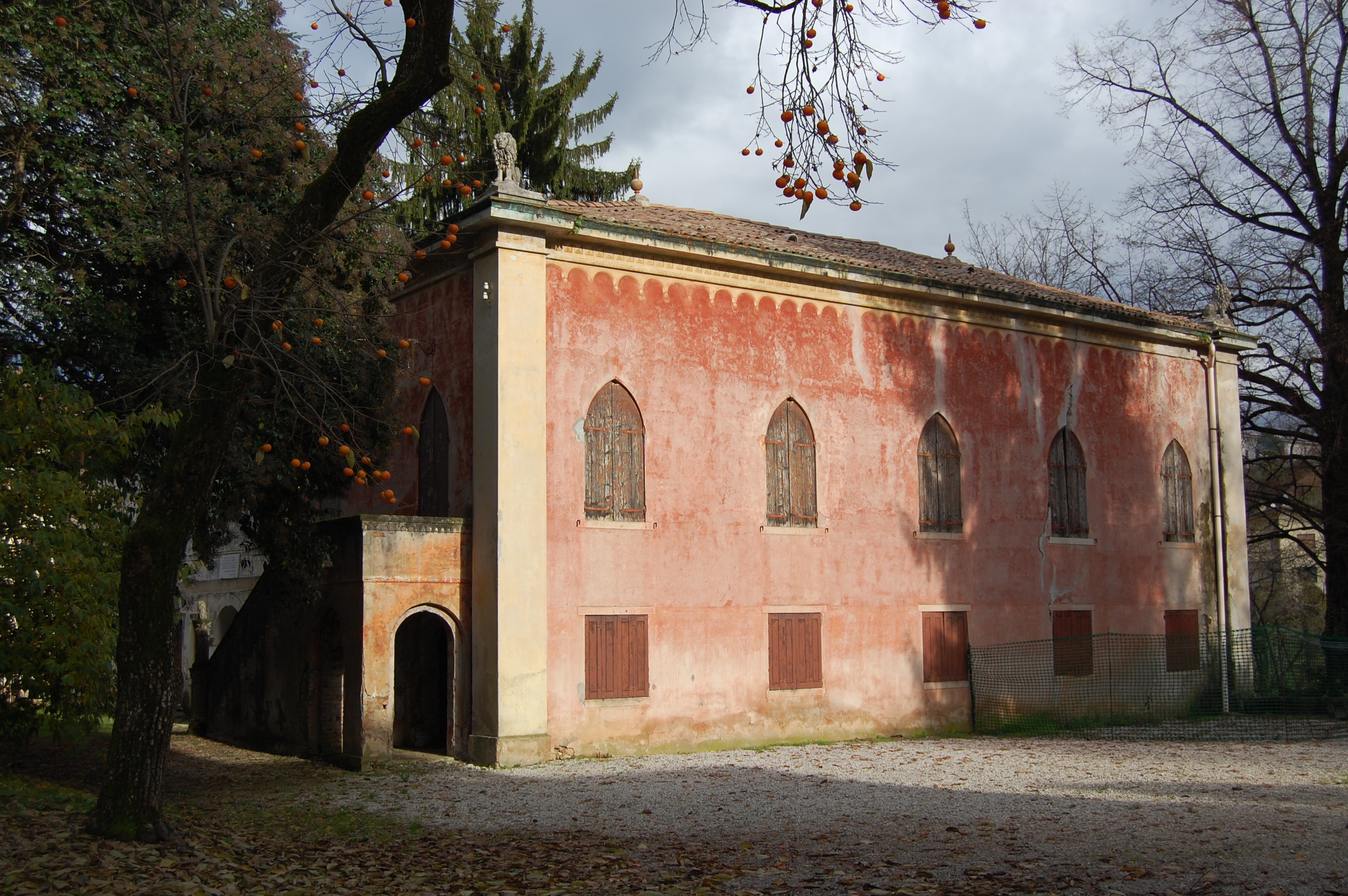Villa Spada
 Dimore storiche
Dimore storiche
Descrizione
A Refrontolo si trovano tre ville venete: Villa Spada, Villa Capretta e Villa Ciardi.
Villa Spada è situata nel centro di Refrontolo. La costruzione della Villa fu iniziata nella seconda metà del Seicento ad opera della famiglia Marzer, che prese in seguito il cognome di Battaglia, e fu completata nel tardo Ottocento, epoca in cui passò agli Spada.
Nel primo Novecento era chiamata Villa Antonietta e si configurava come una vera e propria residenza signorile. C’erano il parco-giardino, la sala delle biciclette, la sala scherma, l’oratorio privato, la rimessa delle carrozze con landau. Le scuderie erano situate ad occidente, presso l’attuale fabbricato Meneghetti. Le sale interne erano arredate con biliardo, pianoforte e il suggestivo melodium a cartoni forati.
Le fasi di costruzione della Villa possono essere sintetizzate in una prima fase seicentesca, di cui si conserva il corpo di fabbrica a “L”, collocato sul lato nord-orientale della corte, una fase ottocentesca che vede la costruzione dell’edificio denominato “casa rossa”, con impianto in parte simmetrico, unito ad angolo retto al corpo seicentesco, e una seconda fase ottocentesca che vede la costruzione di altri corpi di fabbrica che ampliano il complesso sul lato orientale, dove il terreno scendeva in leggero pendio fino al campo da tennis, trasformato successivamente in prato e ora campo sportivo. La fase settecentesca vede la ristrutturazione del corpo di fabbrica sul lato occidentale, a ridosso della via della Chiesa, con caratteri formali autonomi, successivamente rimaneggiato.
A completamento della Villa, situata in prossimità della Chiesa, si trova la Barchessa su due piani, restaurata nel tardo Ottocento.
Durante l’invasione nemica del 1917-18 si insediarono e si susseguirono i vari comandi degli invasori.
Recentemente, come sopra anticipato, molti beni della famiglia Spada sono stati donati alla comunità locale. In particolare, al Comune sono stati donati:
- nel complesso della Villa il piano terra della Barchessa, dove si svolge la annuale mostra dei vini che occupa anche il portico esterno,
- una parte dello spazio a parco,
- una porzione della Villa denominata “casa rossa”
Di recente infine è stata donata al Comune, da parte della famiglia Candiani di Venezia, un’altra porzione del complesso.
È chiara l’importanza dell’acquisizione del bene per il Comune di Refrontolo, sia in relazione al puro valore e prestigio architettonico e storico della Villa, sia in relazione alle strategie di programmazione e gestione dell’amministrazione pubblica.
E’ da ricordare inoltre che lo scrittore Andrea Molesini ha vinto nel 2011 il premio Campiello e Comisso con il libro Non tutti i bastardi sono di Vienna, opera che narra le vicende dell'occupazione da parte di ufficiali tedeschi e austriaci di Villa Spada.
Refrontolo boasts three Venetian villas: Villa Spada, Villa Capretta and Villa Ciardi.
Villa Spada is located in the centre of Refrontolo. Construction work on the villa began in the second half of the 17th Century by the Marzer family who subsequently changed their surname to Battaglia, and work was completed in the late 19th Century when it passed to the Spada family.
In the early 20th Century it was called Villa Antonietta and was set up like a genuine stately home. There was the garden and parkland, the bicycle room, the fencing parlour, the private oratory, the carriage store complete with landau. The stables were located to the west, near what is now the Meneghetti building. The interior of the villa contained a billiard room, a piano and a charming piano-roll melodeon.
The stages in the villa’s construction can be summarised as follows. Phase one in the 17th Century from which the L-shaped building remains, located on the north-eastern side of the courtyard. Then there is the 19th Century stage in which the building known as the “casa rossa” (red house) was added, built to a symmetrical design linked at right angles to the 17th Century edifice. Later on in the 19th Century other buildings were added, extending the whole complex on the eastern side where the land sloped gently downward to the tennis court, later transformed into a meadow and now a sports field. During the 18th Century stage the original building was refurbished on the western side near to the church road, with its own formal style features which were subsequently redesigned.
To complete the villa, the Barchessa was built near the church, a rural outbuilding on two floors restored in the late 19th Century.
During the enemy invasion of 1917-18 the villa was occupied by a succession of invasion army commanders.
As stated above, a great deal of the property of the Spada family has been donated to the local community. The municipal authority has been gifted the following assets.
- The ground floor of the Barchessa outbuilding which houses the annual wine exhibition that also occupies the outside portico,
- Part of the park space,
- The part of the villa known as the “casa rossa”.
Recently the Candiani family of Venice donated another part of the villa complex to the municipal authority.
The acquisition of such assets is of obvious importance for the Municipality of Refrontolo, in terms of the villa’s purely architectural prestige and historical value but also in relation to the planning and management strategies of the local authority.
It should also be remembered that the writer Andrea Molesini won the 2011 Campiello and Comisso literary prizes with his debut novel Non Tutti i Bastardi Sono di Vienna (Not all the Bastards are from Vienna), a work that tells the story of the occupation of Villa Spada by German and Austrian army officers.
In Refrontolo befinden sich drei Venetische Villen: Villa Spada, Villa Capretta und Villa Ciardi.
Villa Spada liegt in der Altstadt von Refrontolo. Der Bau der Villa wurde in der zweiten Hälfte des 17. Jahrhunderts im Auftrag der Familie Marzer begonnen, die später den Nachnamen Battaglia annahm, wurde Ende des 19. Jahrhunderts vollendet und ging dann in den Besitz der Spada über.
Anfang des Zwanzigsten Jahrhunderts wurde sie Villa Antonietta genannt und war ein ausgesprochenes Herrenhaus. Es gab einen parkähnlichen Garten, einen Raum für die Fahrräder, ein Fechtsaal, einen privaten Betraum, einen Schuppen für die Landauer-Kutschen. Die Reitställe waren im westlichen Bereich in der Nähe des jetzigen Gebäude Meneghetti untergebracht. Die Räumlichkeiten waren mit Billard, Klavier und einem eindrucksvollen Harmonium mit Lochkartons ausgestattet.
Die Bauphasen der Villa umfassen einen ersten Abschnitt im 17. Jahrhundert, von dem noch das „L“-förmige Gebäude im nordöstlichen Hofbereich erhalten ist, eine weitere Phase im 19. Jahrhundert, während der ein Bauteil namens „Casa rossa” (rotes Haus) mit teilweise symmetrischem Grundriss entstand, der im rechten Winkel an das Gebäude aus dem 17. Jahrhundert angebaut wurde, sowie eine zweite Phase im 19. Jahrhundert, in der andere Baukörper errichtet wurden, die den Komplex auf der östlichen Seite erweiterten, wo der Boden mit leichter Neigung bis zum Tennisplatz abfiel, der in der Folge in einen Rasen und später in einen Sportplatz verwandelt wurde. Im achtzehnten Jahrhundert wurde der Gebäudeteil auf der Westseite an der Via Della Chiesa umgebaut und erhielt äußerlich ein unabhängiges Erscheinungsbild, das später wieder verändert wurde.
In der Nähe der Kirche wird die Villa von einem zweistöckigen Wirtschaftsgebäude ergänzt, das Ende des 19. Jahrhunderts restauriert wurde.
Während des Vorstoßes der feindlichen Mächte in den Jahren 1917-18 wurde die Villa von verschiedenen Oberkommandos der Invasoren besetzt, die einander ablösten.
In den letzten Jahren wurden, wie bereits oben erwähnt, viele Besitztümer der Familie Spada der Gemeinde übereignet. Darunter sind die folgenden Schenkungen zu nennen:
- im Komplex der Villa das Erdgeschoss des Wirtschaftsgebäudes Barchessa, in dem die jährlich stattfindende Weinschau veranstaltet wird, die auch den äußeren Laubengang in Anspruch nimmt,
- ein Teil der Parkfläche,
- ein Bereich der Villa namens „Casa rossa”.
Vor kurzem wurde der Gemeinde ein weiterer Teil des Gebäudekomplexes von der venezianischen Familie Candiani als Schenkung vermacht.
Die Bedeutung dieses Immobilienbesitzes für die Gemeinde Refrontolo ist offensichtlich – schon allein aufgrund des Wertes und des architektonischen und historischen Prestiges der Villa, aber auch in Hinblick auf die Strategien der öffentlichen Verwaltung bei der Programmierung und Handhabung.
Es ist außerdem erwähnenswert, dass der Schriftsteller Andrea Molesini 2011 für sein Buch „Non tutti i bastardi sono di Vienna” (etwa: Nicht alle Schweine kommen aus Wien) mit dem Preis „Campiello e Comisso” ausgezeichnet wurde. Das Werk erzählt die Geschichte der Besetzung von Villa Spada durch deutsche und österreichische Offiziere.



